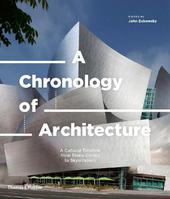
|
A Chronology of Architecture: A Cultural Timeline from Stone Circles to Skyscrapers
Hardback
Main Details
| Title |
A Chronology of Architecture: A Cultural Timeline from Stone Circles to Skyscrapers
|
| Authors and Contributors |
Edited by John Zukowsky
|
| Physical Properties |
| Format:Hardback | | Pages:272 | | Dimensions(mm): Height 245,Width 216 |
|
| Category/Genre | Architecture
History of architecture |
|---|
| ISBN/Barcode |
9780500343562
|
| Classifications | Dewey:720.9 |
|---|
| Audience | |
|---|
| Illustrations |
with over 300 illustrations
|
|
Publishing Details |
| Publisher |
Thames & Hudson Ltd
|
| Imprint |
Thames & Hudson Ltd
|
| Publication Date |
14 November 2019 |
| Publication Country |
United Kingdom
|
Description
A Chronology of Architecture presents a fresh perspective on the medium by taking a purely chronological approach to its history, tracing the complex links between structural innovations, social changes, and artistic interventions. Organized around a central timeline that charts the development of architecture from the earliest structures to the present-day skyscrapers and global cities, it features key buildings, together with commentaries and contextual information about the social, political and cultural events of the period in which they were built. Special feature spreads highlight important movements, construction methods and key practitioners. Covering a wide selection of genres, styles and architects, it is invaluable as a comprehensive guide to architecture in all its different forms.
Author Biography
John Zukowsky is an architectural historian and retired museum professional, and the author of numerous books. He was curator of architecture at the Art Institute of Chicago from 1978 to 2004 and has held several executive positions at institutions in Chicago, New York and Ohio. Among his books is Architecture Inside and Out, also published by Thames & Hudson.
ReviewsInvaluable... Provides a comprehensive, straightforward presentation of how the many styles and forms of architecture developed, of buildings that are considered canonical, and of the historical relationships between architecture and broader cultural, political, and social developments.-- "Choice"
|